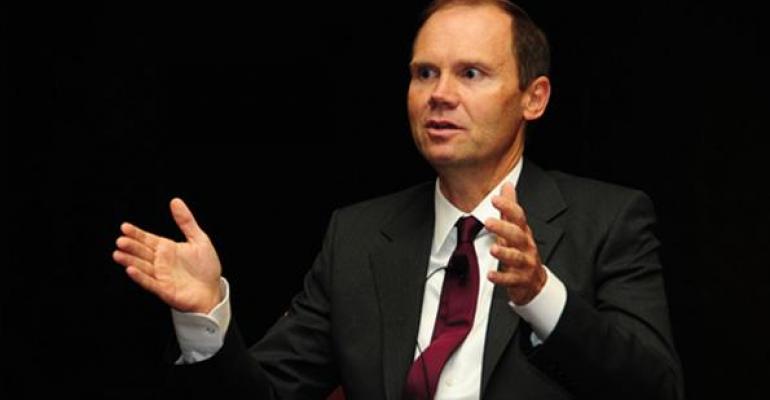When Joe Mansueto started Morningstar Inc., the investment research firm, out of his Chicago apartment 33 years ago, mutual funds had a total of $300 billion in assets. Now the total has mushroomed to $16 trillion, and ETFs, which didn’t even exist in any meaningful way when Morningstar began, are growing at an even faster rate.
Armed with an MBA from the University of Chicago and, reportedly, $80,000, he created the firm because he saw a need for an objective platform to help investors navigate the dizzying array of funds flooding the marketplace. From there, Morningstar grew to include a number of tools for independent advisors, including practice management research, portfolio construction and analysis, as well as ByAllAccounts, a data-aggregation service for advisors and a Wealthmanagement.com Industry Award recipient.
Mansueto, 60, recently retired as CEO and will be succeeded by Kunal Kapoor (though he remains chair of the board). Wealthmanagement.com recently chatted with the founder to get his views on the advisory industry’s evolution over the past three decades and how Morningstar grew up alongside it.
What led you to start Morningstar?
I saw the mutual fund industry was growing, but there weren’t sources of information for investors to make smart decisions. I had all kinds of data as a stock analyst at Harris Associates that mutual fund investors didn’t. People were making bad decisions. I wanted to bring the same rigorous analysis that institutional investors enjoyed for stocks to mutual fund investors.
We quickly discovered financial advisors, who were just beginning to break away from wire houses and needed research help. We became the research department for independent financial advisors.
What are the biggest changes you have seen in the investment industry?
The industry has grown dramatically. Mutual funds have gone from a niche investment to something mainstream. Household penetration for mutual funds was 13-14 percent when we started. Now it’s in the mid-40s. The only industry with growth as strong during that period is personal computers.
Then there’s the rise of the index fund. The initial Vanguard fund had $230 million of assets in 1984. It was still [Vanguard founder Jack] Bogle’s folly, just starting to take off. Now the fund has $280 billion. The rise of passive investing is absolutely a good thing. It provides low cost, broad diversification and minimal taxes.
ETFs are another component. They were introduced in the ‘90s and now have assets of $2.5 trillion. Their popularity has exploded in the last 15 years. There are tax advantages, lower costs and they trade more easily than mutual funds.
What about the financial advisor side?
We’ve seen the rise of the fee-based advisor. Previously it was a stockbroker selling stocks and bonds on commissions. Funds weren’t used. Then advisers got behind funds. When I started there was a thought that no-load funds would take over. But people wanted a financial advisor. Fee-based advice is a good thing, aligning the interests of advisers and their clients. It’s a model that’s proven effective over time if fees are reasonable.
Can you talk about retirement investing?
The 401(k) plan ushered in the rise of the retirement industry. The 401(k) was introduced in the mid-70s and really accelerated in the 1990s. Individuals were suddenly exposed to mutual funds and retirement investing. The whole rise of the retirement industry was a layer of growth for the fund industry. It was transformational.
What has changed in terms of investment information?
There has been a democratization of that information over the past 30 years. It was hard to find this information when we started. I think we’ve played a lead role in the democratization. It’s making institutional-quality information available to individuals at low or no cost. It empowers investors to take control of their own financial future. They can make decisions in their own interests. That is one of the most gratifying things about Morningstar.
Is there any downside to the wealth of information?
Not really. Transparency is good. People could always misuse information. Actually there is one possible downside: with the flood of real-time information, people tend to trade too much. It’s much harder to be a buy and hold investor now. Information can induce people to sell too quickly. You want to ride through volatility. The biggest mistake in 2008-2009 was selling.
What’s your view about the growth of alternative assets?
I approach them with skepticism. Just because people call themselves hedge fund managers doesn’t mean they’re any smarter than mutual fund managers. I’m skeptical most investors need alternatives. They can provide diversification in moderation. But they come with higher fees, so you have to make sure you can justify them. I don’t use alternatives. I think buying high quality companies and more plain vanilla fixed income securities is the way to go.
Any other important developments worth mentioning?
When I started in the fund industry, it was full of boutiques. Founders’ names were on the door with well-articulated philosophies. As the industry grew, big business entered the mutual fund industry. It became more of a business and less of a profession.
As this happened, there was a demand for more reliable performance. And so came the growth of closet indexing [actively-managed funds with a portfolio that closely resembles a market index]. These funds give you passive performance with active fees. Too many mediocre funds were created. There’s a strong case for both active and passive funds, but not this mushy middle. These closet-index funds should be driven from the industry. I hope we get back to a time when it’s more of a profession again. Active management still has great potential.





